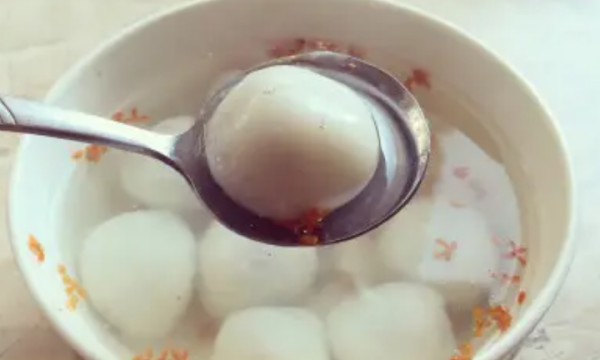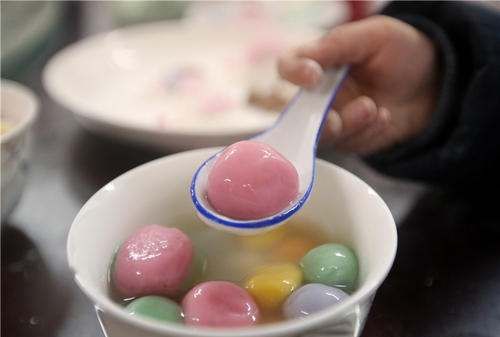本文目录
钟南山用英语简绍
词目:汤圆
拼音:tāng yuán
英文:glue pudding &sweet dumplings
基本解释 [boiled rice dumpling;stuffed dumpling made partly or wholly of glutinous rice flour served in soup] 糯米粉等做的球形食品,一般有馅儿,煮熟带汤吃
汤圆的英文单词是什么?
Tangyuan, also known as "Tangtuan" and "Fuyuanzi", is one of the representative traditional snacks of the Han nationality. At the same time, it is also the most characteristic food of the Lantern Festival, a traditional Chinese festival, which also expresses the yearning and expectation of the ancient people for a happy life.
Tangyuan was first called "Fuyuanzi" and later "Tangyuan", also known as Yuanxiao. "Tangyuan" is made of sesame, bean paste, walnut, nut and jujube paste. It is wrapped in a round shape with glutinous rice powder. It can be both meat and vegetable with different flavors. Soup can be boiled, fried, steamed food, reunion happy meaning.
汤圆,别称“汤团”“浮元子”,是汉族传统小吃的代表之一。同时,也是中国的传统节日元宵节所最具有特色的食物,也表达了古代人民对幸福生活的一种向往和期盼。
汤圆最早叫“浮元子”后称“汤圆”,又称元宵;“汤圆”以芝麻、豆沙、核桃仁、果仁、枣泥等为馅料,用糯米粉包成圆形,可荤可素,风味各异。可汤煮、油炸、蒸食,有团圆美满之意。

汤圆由来
据传,汤圆起源于宋朝。当时的明州(现浙江省宁波市)所兴起的一种新奇食品,即用黑芝麻、猪板油做馅、加入少许白糖,外面用糯米粉搓成圆形,煮熟后,吃起来香甜软糯,回味无穷。
同时,汤圆象征合家团圆美满,吃汤圆也意味着在新的一年里合家幸福、团团圆圆,所以是正月十五元宵节必备美食。
元宵的起源英文介绍
元宵节,又称上元节、小正月、元夕或灯节,是春节之后的第一个重要节日,是中国亦是汉字文化圈的地区和海外华人的传统节日之一。你知道怎么用英文介绍元宵节吗?现在我就带你来看看。
关于元宵节及相关习俗的英语介绍
Popular Chinese name: 元宵节 'first night festival'
Alternative Chinese name: 上元节 'first first festival'
Date: Lunar calendar month 1 day 15 (February 22, 2016)
Importance: ends China's most important festival, Spring Festival
Celebrations: enjoying lanterns, lantern riddles, eating tangyuan a.k.a. yuanxiao (ball dumplings in soup), lion dances, dragon dances, et.
History: about 2,000 years
Greeting: Happy Lantern Festival! 元宵节快乐!
The Lantern Festival is Very Important
The Lantern Festival is the last day (traditionally) of China's most important festival, Spring Festival (春节 Chūnjié /chwn-jyeah/ a.k.a. the Chinese New Year festival). After the Lantern Festival, Chinese New Year taboos are no longer in effect, and all New Year decorations are taken down.
The Lantern Festival is also the first full moon night in the Chinese calendar, marking the return of spring and symbolizing the reunion of family. However, most people cannot celebrate it with their families, because there is no public holiday for this festival.
When Did the Lantern Festival Begin?
The Lantern Festival can be traced back to 2,000 years ago.
In the beginning of the Eastern Han Dynasty (25–220), Emperor Hanmingdi was an advocate of Buddhism. He heard that some monks lit lanterns in the temples to show respect to Buddha on the fifteenth day of the first lunar month. Therefore, he ordered that all the temples, households, and royal palaces should light lanterns on that evening.
This Buddhist custom gradually became a grand festival among the people.
How Do Chinese Celebrate the Lantern Festival?
According to China's various folk customs, people get together on the night of the Lantern Festival to celebrate with different activities.
As China is a vast country with a long history and diverse cultures, Lantern Festival customs and activities vary regionally, including lighting and enjoying (floating, fixed, held, and flying) lanterns, appreciating the bright full moon, setting off fireworks, guessing riddles written on lanterns, eating tangyuan, lion dances, dragon dances, and walking on stilts.
The most important and prevalent customs are enjoying lanterns, guessing lantern riddles, eating tangyuan, and lion dances.
Lighting and Watching Lanterns放花灯、看花灯
Lighting and appreciating lanterns is the main activity of the festival. When the festival comes, lanterns of various shapes and sizes (traditional globes, fish, dragons, goats! — in 2015, up to stories high!) are seen everywhere including households, shopping malls, parks, and streets, attracting numerous viewers. Children may hold small lanterns while walking the streets.
The lanterns' artwork vividly demonstrates traditional Chinese images, such as fruits, flowers, birds, animals, people, and buildings.
In the Taiwanese dialect, the Chinese word for lantern (灯 dēng) is pronounced similarly to (丁 dīng), which means 'a new-born baby boy'. Therefore lighting lanterns means illuminating the future and giving birth.
Lighting lanterns is a way for people to pray that they will have smooth futures and express their best wishes for their families. Women who want to be pregnant would walk under a hanging lantern praying for a child.
Guessing Lantern Riddles 猜灯谜
Guessing (solving) lantern riddles, starting in the Song Dynasty (960–1279), is one of the most important and popular activities of the Lantern Festival. Lantern owners write riddles on paper notes and pasted them upon the colorful lanterns. People crowd round to guess the riddles.
If someone thinks they have the right answer, they can pull the riddle off and go to the lantern owner to check their answer. If the answer is right, there is usually a small gift as a prize.
As riddle guessing is interesting and informative, it has become popular among all social strata.
Lion Dances舞狮子
The lion dance is one of the most outstanding traditional folk dances in China. It can be dated back to the Three Kingdoms Period (220–280).
Ancient people regarded the lion as a symbol of bravery and strength, and thought that it could drive away evil and protect people and their livestock. Therefore, lion dances are performed at important events, especially the Lantern Festival, to ward off evil and pray for good fortune and safety.
The lion dance requires two highly-trained performers in a lion suit. One acts as the head and forelegs, and the other the back and rear legs. Under the guidance of a choreographer, the "lion" dances to the beat of a drum, gong, and cymbals. Sometimes they jump, roll, and do difficult acts such as walking on stilts.
In one lion dance, the "lion" moves from place to place looking for some green vegetables, in which red envelopes with money inside are hidden. The acting is very amusing and spectators enjoy it very much.
Nowadays, the lion dance has spread to many other countries with overseas Chinese, and it is quite popular in countries like Malaysia and Singapore. In many Chinese communities of Europe and America, Chinese people use lion dances or dragon dances to celebrate every Spring Festival and other important events.
Eating Tangyuan (Yuanxiao) 吃汤圆(元宵)
Eating Tangyuan is a very important custom of the Lantern Festival.
Eating tangyuan is an important custom of the Lantern Festival. Tangyuan (汤圆 tāngyuán /tung-ywen/ 'soup round') are also called yuanxiao when eaten for the Lantern Festival, after the festival.
These ball-shaped dumplings made of glutinous rice flour, with different fillings are stuffed inside, usually sweet, such as white sugar, brown sugar, sesame seeds, peanuts, walnuts, rose petals, bean paste, and jujube paste, or any combination of two or three ingredients. Yuanxiao can be boiled, fried, or steamed, and are customarily served in fermented rice soup, called tianjiu (甜酒 tián jiǔ /tyen-jyoh/ 'sweet liquor').
As tangyuan is pronounced similarly to tuanyuan (团圆 /twan-ywen/ 'group round'), which means the whole family gathering together happily, Chinese people believe that the round shape of the balls and their bowls symbolize wholeness and togetherness. Therefore, eating tangyuan on the Lantern Festival is a way for Chinese people to express their best wishes for their family and their future lives.
It is believed that the custom of eating tangyuan originated during the Song Dynasty, and became popular during the Ming (1368–1644) and Qing (1644–1911) periods.
关于元宵节,英语怎么说?
正月是农历的元月,古人称夜为“宵”,所以称正月十五为元宵节。
正月十五日是一年中第一个月圆之夜,也是一元复始,在这个大地回春的夜晚,人们对此加以庆祝,也是庆贺新春的延续。
元宵节又称为“上元节”。按中国民间的传统,在这天上皓月高悬的夜晚,人们要点起彩灯万盏,以示庆贺。出门赏月、燃灯放焰、喜猜灯谜、共吃元宵,合家团聚、同庆佳节,其乐融融。
下面就向大家介绍一些元宵节常用词语的英文说法:
the Lantern Festival 元宵节
rice glue ball 元宵
glutinous rice 糯米
lions/dragons dancing 舞龙/舞狮
guess lantern riddles 猜灯谜
play couplets game 对对联
enjoy beautiful lanterns 赏花灯
snuff 灯花
exhibit of lanterns 灯会
dragon lantern dancing 耍龙灯
walking on stilts 踩高跷
land boat dancing 划旱船
yangko/yangge dance 扭秧歌
beating drums while dancing 打太平鼓
drum dance 腰鼓舞
fireworks party 焰火大会
traditional opera 戏曲
variety show/vaudeville 杂耍
Lantern Festival's temple fair 元宵庙会
汤圆的做法英文介绍
Tangyuan is a Chinese dessert made from glutinous rice flour mixed with a small amount of water to form balls and is then cooked and served in boiling water.
汤圆是中国的传统甜品,用糯米粉浸入少量水揉成球状,放入水里煮,食用时带汤盛出。
Its history can date back to the Song Dynasty.
汤圆的历史可追溯到宋朝时期。

In Chinese, the pronunciation of Tangyuan is similar to the word Tuanyuan, which has the meaning of reunion and happiness in Chinese.
汤圆的中文发音近似于“团圆”的发音,因此有“团团圆圆,幸福美满”之意。
They are traditionally eaten during the Lantern Festival, but also served as a dessert on Chinese wedding day, Dongzhi, and any occasions such as family reunion.
按传统习俗,汤圆在元宵节、婚礼、冬至和家庭团聚的时候作为点心食用。
以上就是关于汤圆的英文介绍50字 ,钟南山用英语简绍的全部内容,以及汤圆的英文介绍50字 的相关内容,希望能够帮到您。

